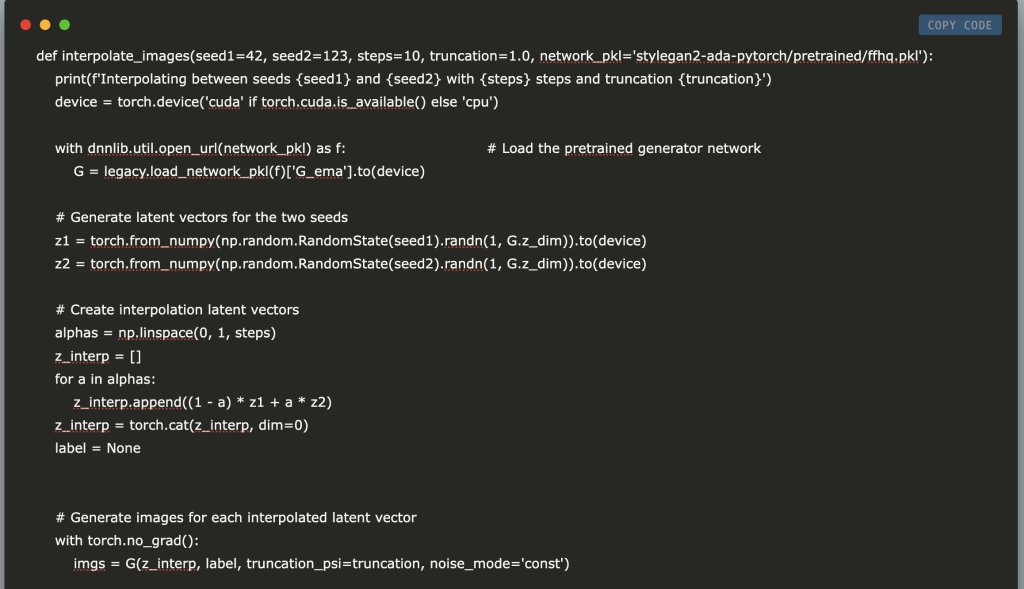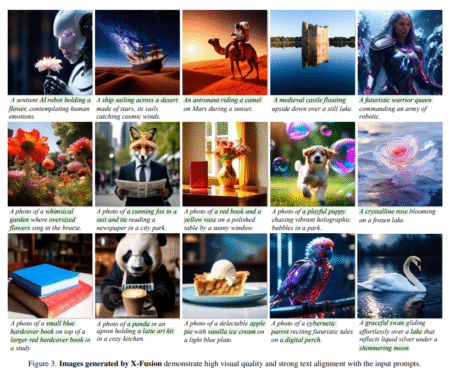

In this tutorial, we will do an in-depth, interactive exploration of NVIDIA’s StyleGAN2‑ADA PyTorch model, showcasing its powerful capabilities for generating photorealistic images. Leveraging a pretrained FFHQ model, users can generate high-quality synthetic face images from a single latent seed or visualize smooth transitions through latent space interpolation between different seeds. With an intuitive interface powered by interactive widgets, this tutorial is a valuable resource for researchers, artists, and enthusiasts looking to understand and experiment with advanced generative adversarial networks.
!git clone https://github.com/NVlabs/stylegan2-ada-pytorch.gitFirst, we clone the NVIDIA StyleGAN2‑ADA PyTorch repository from GitHub into your current Colab workspace.
!mkdir -p stylegan2-ada-pytorch/pretrained
!wget https://nvlabs-fi-cdn.nvidia.com/stylegan2-ada-pytorch/pretrained/ffhq.pkl -O stylegan2-ada-pytorch/pretrained/ffhq.pklIn this code part, the first command creates the necessary directory (if it doesn’t already exist) for storing pretrained models. The second command downloads the FFHQ pretrained model and saves it in that directory for use with the StyleGAN2‑ADA model.
import sys
sys.path.append('stylegan2-ada-pytorch')In this code, we add the “stylegan2-ada-pytorch” directory to Python’s module search path, ensuring that modules from the repository can be easily imported and used.
import torch
import numpy as np
import PIL.Image
import matplotlib.pyplot as plt
import ipywidgets as widgets
from IPython.display import displayHere, we import statements and load essential libraries for deep learning, numerical operations, image processing, visualization, and interactive controls into your code. These libraries ensure you have the tools to build, manipulate, and display generated images interactively.
import legacy
import dnnlib
def generate_image(seed=42, truncation=1.0, network_pkl='stylegan2-ada-pytorch/pretrained/ffhq.pkl'):
print(f'Generating image with seed {seed} and truncation {truncation}')
device = torch.device('cuda' if torch.cuda.is_available() else 'cpu')
with dnnlib.util.open_url(network_pkl) as f: # Load the pretrained generator network
G = legacy.load_network_pkl(f)['G_ema'].to(device)
z = torch.from_numpy(np.random.RandomState(seed).randn(1, G.z_dim)).to(device) # Create a latent vector using the provided seed
label = None # FFHQ is unconditional
with torch.no_grad(): # Generate image
img = G(z, label, truncation_psi=truncation, noise_mode='const')
# Convert image tensor to uint8 and format for display
img = (img + 1) * (255/2)
img = img.clamp(0,255).to(torch.uint8)
img = img[0].permute(1,2,0).cpu().numpy()
plt.figure(figsize=(4,4))
plt.imshow(img)
plt.axis('off')
plt.show()
In this part, we define a function called generate_image that Loads the pretrained StyleGAN2‑ADA generator network from a given URL. Creates a latent vector based on a seed, generates an image with a specified truncation parameter, and then processes and displays the resulting image using matplotlib.
def interpolate_images(seed1=42, seed2=123, steps=10, truncation=1.0, network_pkl='stylegan2-ada-pytorch/pretrained/ffhq.pkl'):
print(f'Interpolating between seeds {seed1} and {seed2} with {steps} steps and truncation {truncation}')
device = torch.device('cuda' if torch.cuda.is_available() else 'cpu')
with dnnlib.util.open_url(network_pkl) as f: # Load the pretrained generator network
G = legacy.load_network_pkl(f)['G_ema'].to(device)
# Generate latent vectors for the two seeds
z1 = torch.from_numpy(np.random.RandomState(seed1).randn(1, G.z_dim)).to(device)
z2 = torch.from_numpy(np.random.RandomState(seed2).randn(1, G.z_dim)).to(device)
# Create interpolation latent vectors
alphas = np.linspace(0, 1, steps)
z_interp = []
for a in alphas:
z_interp.append((1 - a) * z1 + a * z2)
z_interp = torch.cat(z_interp, dim=0)
label = None
# Generate images for each interpolated latent vector
with torch.no_grad():
imgs = G(z_interp, label, truncation_psi=truncation, noise_mode='const')
imgs = (imgs + 1) * (255/2)
imgs = imgs.clamp(0,255).to(torch.uint8).cpu().numpy()
plt.figure(figsize=(steps * 2, 2)) # Plot images in a row to visualize the interpolation
for i in range(steps):
plt.subplot(1, steps, i+1)
img = np.transpose(imgs[i], (1,2,0))
plt.imshow(img)
plt.axis('off')
plt.show()
Here, we define interpolate_images, which generates images by interpolating between latent vectors derived from two seeds. It loads the pretrained StyleGAN2‑ADA generator, computes a smooth transition between the latent codes of the two seeds over a specified number of steps, and then displays the resulting images in a row to visualize the interpolation.
In conclusion, we demonstrated a versatile and hands-on approach using NVIDIA’s StyleGAN2‑ADA model for static image generation and dynamic latent space interpolation. By allowing users to adjust parameters such as seed values and truncation levels interactively, this notebook provides insight into the intricacies of GAN-based image synthesis and fosters creativity and innovation.
Here is the Colab Notebook for the above project. Also, don’t forget to follow us on Twitter and join our Telegram Channel and LinkedIn Group. Don’t Forget to join our 75k+ ML SubReddit.
 Recommended Read- LG AI Research Releases NEXUS: An Advanced System Integrating Agent AI System and Data Compliance Standards to Address Legal Concerns in AI Datasets
Recommended Read- LG AI Research Releases NEXUS: An Advanced System Integrating Agent AI System and Data Compliance Standards to Address Legal Concerns in AI Datasets
The post A Stepwise Python Code Implementation to Create Interactive Photorealistic Faces with NVIDIA StyleGAN2‑ADA appeared first on MarkTechPost.
Source: Read MoreÂ


